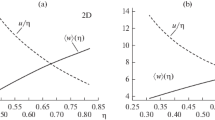Abstract
Random packings ofN⩽2000 rigid disks in the plane, subject to periodic boundary conditions on a square primitive cell, have been generated by a concurrent construction which treats all disks on an equal footing, as opposed to previously investigated sequential constructions. The particles start with random positions and velocities, and as they move about they grow uniformly in size, from points to jammed disks. The collection of packings displays several striking geometric features. These include (for largeN) typically polycrystalline textures with irregular grain boundaries and linear shear fractures. The packings occasionally contain monovacancies and trapped but unjammed “rattler” disks. The latter appear to be confined to the grain boundaries. The linear shear fractures preserve bond orientational order, but disrupt translational order, within the crystalline grains. A new efficient event-driven simulation algorithm is employed to generate the histories of colliding and jamming disks. On a computer which can process one million floating-point instructions per second the algorithm processes more than one million pairwise collisions per hour.
Similar content being viewed by others
References
B. J. Alder and T. E. Wainwright,J. Chem. Phys. 31(2):459–466 (1959).
H. C. Andersen,J. Chem. Phys. 72:2384 (1980).
C. J. Basheet al., IBM's Early Computers (MIT Press, Cambridge, Massachusetts, 1986).
C. H. Bennett,J. Appl. Phys. 43:2727 (1972).
J. D. Bernal,Proc. R. Soc. A 280:299 (1964).
F. P. Buff and F. H. Stillinger,J. Chem. Phys. 39:1911 (1963).
S. Chapman and T. G. Cowling,The Mathematical Theory of Non-Uniform Gases (Cambridge University Press, Cambridge, 1953), Chapters 5 and 6.
K. E. Davis, W. B. Russel, and W. J. Glantschnig,Science 245:507 (1989).
J. J. Erpenbeck and W. W. Wood, Molecular dynamics techniques for hard-core systems, inStatistical Mechanics. Part B:Time-Dependent Processes, B. J. Berne, ed. (Plenum, New York, 1977).
J. L. Finney,Nature 266:309 (1977), and references therein.
H. L. Frisch,Adv. Chem. Phys. 6:229 (1964).
P. H. Gaskell, inGlassy Metals, Vol. II, H. Beck and H.-J. Güntherodt, eds. (Springer, Berlin, 1983), pp. 5–49.
K. Huang and C. N. Yang,Phys. Rev. 105:767 (1957).
M. G. Kendall,A Course in the Geometry of n Dimensions (Hafner, New York, 1961), p. 36.
D. E. Knuth,Art of Computer Programming, Vol. 3,Sorting and Searching (Addison-Wesley, 1973).
T. D. Lee, K. Huang, and C. N. Yang,Phys. Rev. 106:1135 (1957).
P. W. Leung, C. L. Henley, and G. V. Chester,Phys. Rev. B 39:446 (1989).
B. D. Lubachevsky,J. Comp. Phys. (1990).
G. Mason and W. Clark,Nature 207:512 (1965).
C. A. Murray and D. H. van Winkle,Phys. Rev. A 34:562 (1986).
D. R. Nelson and B. J. Halperin,Phys. Rev. B 19:2457 (1979).
R. Pindak, D. J. Bishop, and W. O. Sprenger,Phys. Rev. Lett. 44:1461 (1980).
C. A. Rogers,Packing and Covering (Cambridge University Press, Cambridge, 1964), p. 3.
G. D. Scott,Nature 194:957 (1962).
N. J. A. Sloane,Sci. Am. 250(1):116 (1984).
W. A. Steele,J. Phys. Chem. 69:3446 (1965).
F. H. Stillinger, E. A. DiMarzio, and R. L. Kornegay,J. Chem. Phys. 40:1564 (1964).
F. H. Stillinger and Z. W. Salsburg,J. Stat. Phys. 1:179 (1969).
F. H. Stillinger and T. A. Weber,J. Chem. Phys. 83:4767 (1985).
J. Vieillard-Baron,J. Chem. Phys. 56:4729 (1972).
M. Widom, K. J. Strandburg, and R. H. Swendsen,Phys. Rev. Lett. 58:706 (1987).
Author information
Authors and Affiliations
Rights and permissions
About this article
Cite this article
Lubachevsky, B.D., Stillinger, F.H. Geometric properties of random disk packings. J Stat Phys 60, 561–583 (1990). https://doi.org/10.1007/BF01025983
Received:
Revised:
Issue Date:
DOI: https://doi.org/10.1007/BF01025983




